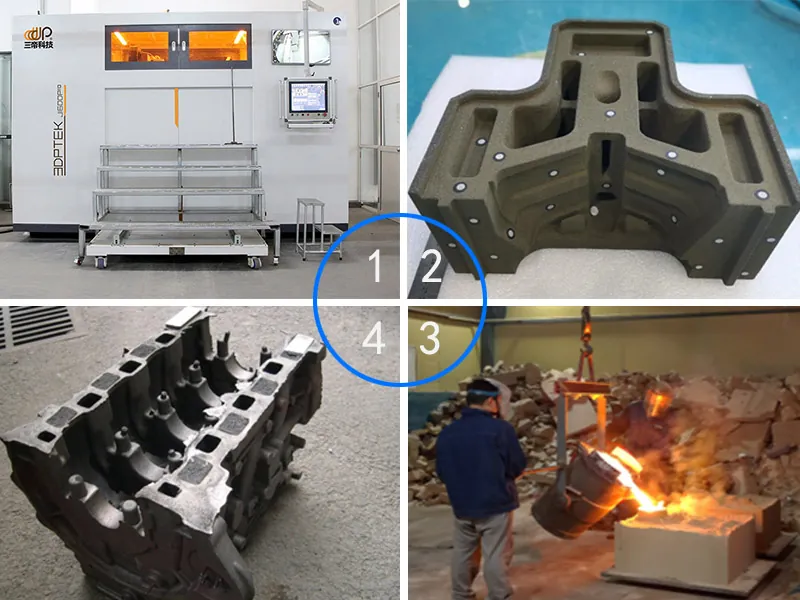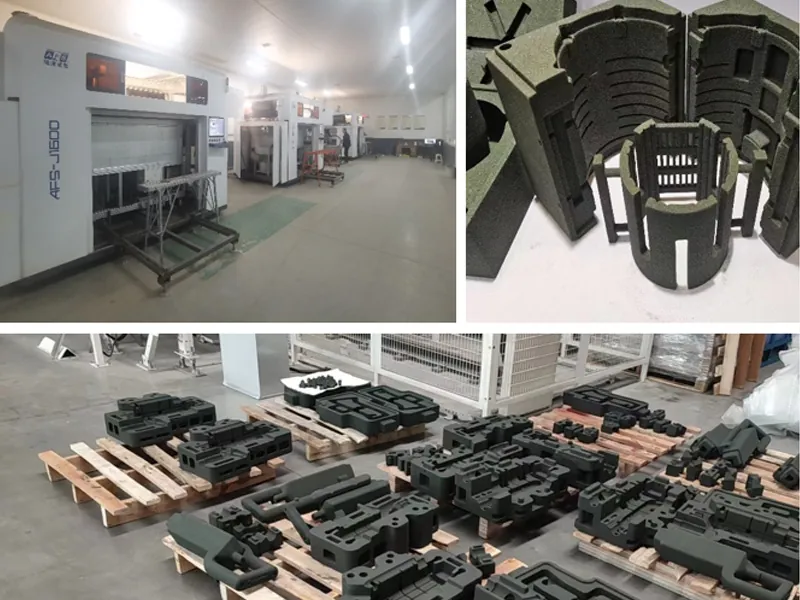3D printing sand casting is an innovative casting method that integrates 3D printing technology and traditional sand casting process. This paper describes its principle, advantages, process and application areas, focusing on its outstanding performance in design freedom, production cycle, accuracy and quality, cost-effectiveness and green environmental protection. This advanced casting technology has revolutionized the manufacture of complex parts for many industries and is of great significance in modern industrial production.
3D printed sand casting is based on a digital three-dimensional model. First of all, the 3D printing equipment is used to print out the sand mold (including upper and lower sand molds, cores, etc.) by stacking special sand materials (usually resin sand containing binder, etc.) layer by layer in accordance with the cross-section information of the model. Then, liquid metal is cast into the cavity formed by the sand mold, and after the liquid metal cools and solidifies, the sand mold is removed to obtain the desired metal casting.

Complex structure molding capabilityTraditional sand casting in the manufacture of complex shapes, such as sand molds with internal cavities, curved channels, shaped surfaces and other structures, by the limitations of the mold manufacturing technology, it is difficult to achieve or the cost is extremely high. The 3D printing sand casting can be based on digital three-dimensional model, easily and accurately print out a variety of complex shapes of sand, for the production of castings with complex structure provides a possibility. For example, the complex cooling channels of aircraft engine blades, automotive parts with fine internal structure, etc., can be realized by 3D printing sand casting.
Personalization3D printing sand casting has a unique advantage for the production of some small batch, customized needs of castings. It can be based on customer-specific requirements, quickly design and print out the corresponding sand, to meet the personalized needs of different customers, to avoid the traditional mold manufacturing needs to open the mold, mold repair and other cumbersome processes, greatly reducing the production cycle of customized products.
Simplification of the mold manufacturing process: Traditional sand casting requires the production of molds first, and then the molds are used to manufacture the sand molds, and the process of designing, manufacturing and commissioning of the molds often takes a lot of time and manpower. And 3D printing sand casting directly based on the digital model for printing, no need to make molds, eliminating the link of mold manufacturing, greatly reducing the entire production cycle 25.
Rapid iteration and modification: In the product development and design phase, if it is found that the design of the casting needs to be modified, traditional sand casting requires the re-making of molds, which is costly and time-consuming. 3D printing sand casting only needs to modify the digital model on the computer, and then reprint the sand model can be, can quickly realize the design iteration and modification, speed up the product development process45.
High dimensional accuracy3D printing technology can accurately control the size and shape of the sand mold, reducing the casting dimensional deviation caused by mold manufacturing errors, parting surface fit and other problems, and improving the dimensional accuracy of the castings. The smooth surface of the printed sand mold makes the surface quality of the final casting better and reduces the subsequent processing and treatment workload4.
Good internal quality: 3D printing sand casting can realize the uniform tightness of the sand pattern, avoiding the local loosening, sand entrapment and other defects that may occur in traditional sand casting, and improving the internal quality of the castings. At the same time, through precise control, the solidification process of the casting can be optimized to reduce the generation of defects such as shrinkage holes and shrinkage loosening.
High material utilization: 3D printing sand casting is on-demand printing, using only the required materials, avoiding the waste of materials in traditional mold manufacturing. Moreover, during the printing process, the distribution of materials can be precisely controlled according to the structure and strength requirements of the sand mold, further improving the utilization of materials.
Reduced labor costs: Traditional sand casting requires a large number of manual operations, such as mold making, sand modeling, mold repair, etc., with high labor costs. The 3D printing sand casting mainly relies on automated equipment for printing, greatly reducing the involvement of manual labor and reducing labor costs. At the same time, it also reduces the errors and uncertainties brought about by manual operation, and improves the stability and consistency of production.
Reduction of waste emissions: Traditional sand casting produces a large amount of waste in the process of mold manufacturing and sand processing, such as discarded mold materials, waste sand, etc., which causes a certain amount of pollution to the environment. The 3D printing sand casting produces less waste, and the remaining materials can be recycled and reused, in line with the requirements of green environmental protection.
Improvement of the production environment: 3D printing sand casting process does not require the use of a large number of chemical reagents and binders, reducing the pollution of the environment and health hazards to the operator. At the same time, the automated production method also reduces the generation of dust and noise, improving the production environment.
Application Areas
Aerospace: Used in the manufacture of aero-engine blades, turbine disks, aircraft structural components and other complex parts to meet the requirements of high strength, lightweight and high performance.
automobile industry: Production of engine blocks, cylinder heads, transmission cases and other components, especially for high-performance engines and new automotive design of complex structural components.
Energy: Applied in the manufacture of key components for gas turbines, power generation equipment, etc. to improve component performance and reliability.
Medical Device Field: Manufacture of customized medical devices such as orthopedic implants and dental prostheses to meet individual patient needs.

3D printed sand casting, as an advanced casting technology, synthesizes the advantages of 3D printing and traditional sand casting. It shows excellent performance in design, production cycle, quality, cost and environmental protection, and brings new ideas and methods for modern industrial manufacturing. With the continuous development and improvement of the technology, 3D printing sand casting is expected to be widely used in more fields, and promote industrial production in the direction of more efficient, more accurate and more environmentally friendly.